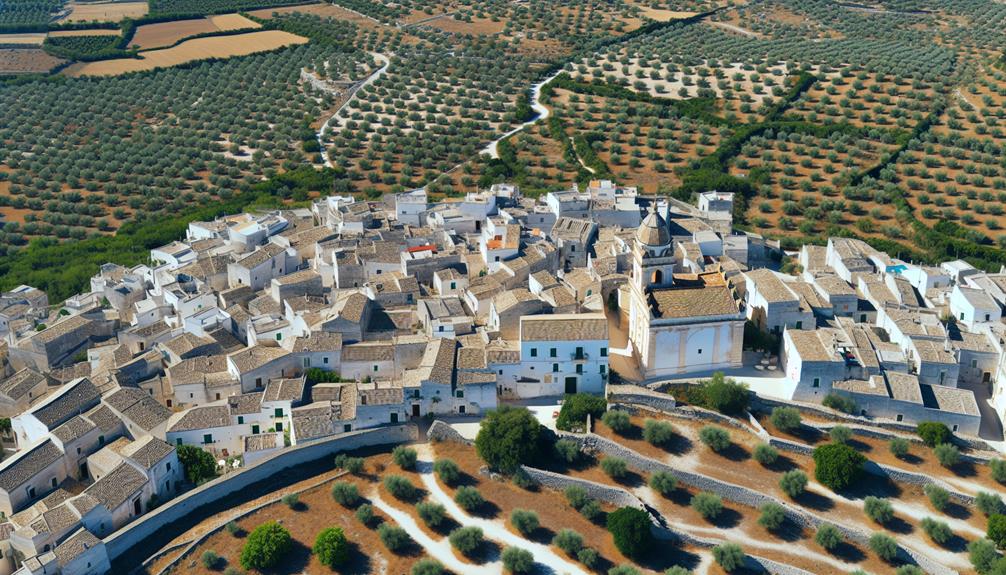Puglia’s ancient villages and historic sites offer a fascinating journey through Italy’s past, with timeless architecture, medieval castles, and centuries-old churches nestled among picturesque landscapes. Each village tells its own unique story, inviting visitors to explore the rich cultural heritage of the region. For a comprehensive guide to the must-visit historic sites, read our detailed article. And to enjoy a comfortable stay nearby, consider Puglia vacation villa rentals for the perfect home base during your travels.
As you wander through Puglia’s ancient villages, you can’t help but be struck by the region’s rich history and enchanting architecture. The iconic trulli of Alberobello and Locorotondo are just the beginning, with their unique conical roofs and narrow streets that seem frozen in time. But what lies beyond these picturesque villages? What secrets do historic sites like Castel del Monte and the Roman ruins of Egnazia hold, and how do they reveal the region’s complex past? As you explore Puglia’s ancient landscape, you’ll start to uncover the layers of history and culture that make this region so unique – but there’s still so much to discover.

Exploring Ancient Villages
Beyond the charming coastline of Puglia lies a treasure trove of ancient villages, each waiting to be discovered.
You’ll find yourself wandering through narrow streets, admiring whitewashed houses, and taking in the rich history that permeates every corner. Trulli, a type of ancient stone hut with conical roofs, are characteristic of the region and can be found in villages like Alberobello and Locorotondo.
As you explore these villages, you’ll notice a mix of medieval and Baroque architecture, with grand churches and quaint town squares. The villages are often perched on hilltops, offering breathtaking views of the surrounding countryside.
You might stumble upon a local market or festival, where you can sample traditional Pugliese cuisine and drinks, such as focaccia and limone.
With their rich history, stunning architecture, and warm hospitality, Puglia’s ancient villages are a must-visit destination for anyone interested in exploring Italy’s hidden gems.
Historic Sites to Visit
As you explore deeper into Puglia’s rich history, you’ll often find yourself at the doorstep of remarkable historic sites that have shaped the region’s identity.
The Castel del Monte, a UNESCO World Heritage Site, is one such location. This 13th-century castle, built by Emperor Frederick II, is a reflection of Puglia’s strategic importance in the medieval period. Its unique blend of Romanesque and Gothic architectural styles makes it a must-visit.
You’ll also want to visit the Roman ruins of Egnazia, which date back to the 5th century BC. The site features an impressive amphitheater, a forum, and several ancient temples.
The nearby town of Ostuni is home to the Museum of Pre-Classical Civilizations, which houses an extensive collection of artifacts from the region’s ancient civilizations.
In addition, the seaside town of Otranto boasts the 15th-century Otranto Cathedral, which features stunning Byzantine mosaics and a crypt that contains the remains of the town’s martyrs.
These historic sites offer a glimpse into Puglia’s complex and fascinating history, and they’re a great place to start your exploration of the region.
Puglia’s Architectural Heritage
Puglia’s architectural heritage is a vibrant tapestry of styles, with one thousand years of history woven into its ancient villages and modern towns. As you explore the region, you’ll notice the influence of various civilizations, from the Romans to the Normans, and the Byzantines to the Baroque period. The result is a diverse and eclectic mix of architectural styles, with each one reflecting the unique cultural and historical context in which it was built.
You’ll see trulli, those iconic whitewashed stone huts with conical roofs, in the countryside and in towns like Alberobello. You’ll marvel at the stunning Romanesque cathedrals, with their intricate stone carvings and ornate facades.
And you’ll be struck by the grandeur of the Baroque architecture, with its sweeping curves and ornate decorations. As you wander through Puglia’s ancient villages and modern towns, you’ll discover a rich and varied architectural heritage that reflects the region’s complex history and cultural identity.
From the simplest trullo to the grandest cathedral, every building tells a story about Puglia’s past and its people.
